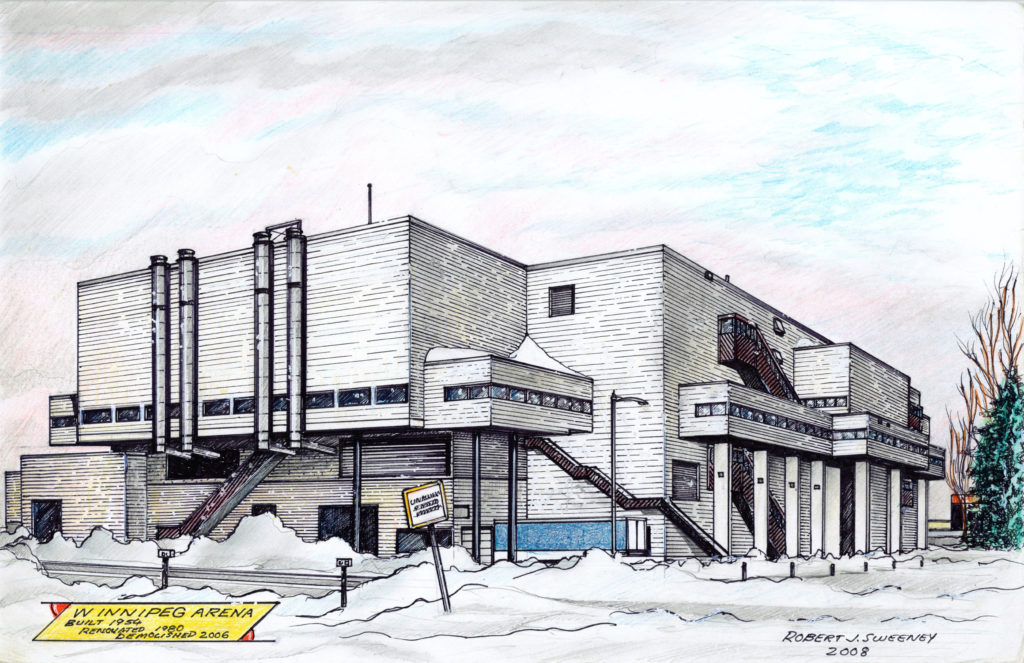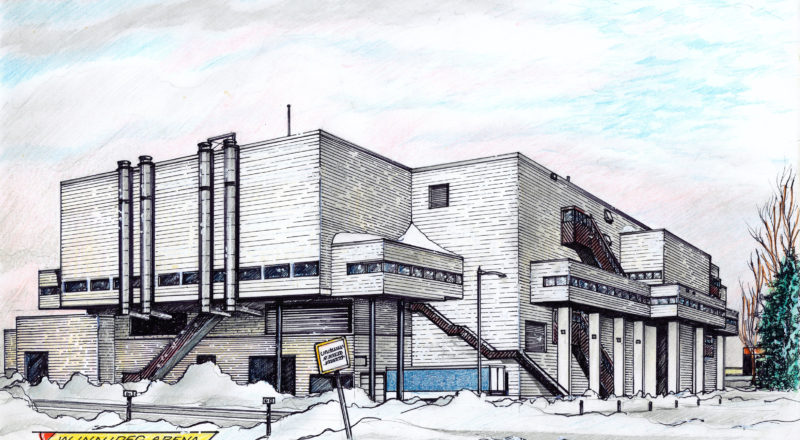
/ Blog
September 15, 2022
Winnipeg’s White House: The Old Winnipeg Arena
Nothing brings Winnipeggers together more than our beloved hockey team, the Jets! As a city, we have been celebrating hockey since the late 1800s. One of the first places in the city to host many of Winnipeg’s hockey teams was the 1909 Winnipeg Amphitheatre. Considered a cramped fire trap by the mid 20th century, Winnipeggers were excited to move into a brand new Winnipeg Arena in 1955, located at 1430 Maroons Road. The original home of the Jets, the blocky white building is now long gone, but the image of it is forever enshrined in the minds of those who attended events there. It was a place of pride and heartbreak, where Winnipeg came together to cheer and cry, making memories that no demolition crew could ever destroy.
Plans for a new $1 million arena in Winnipeg were already being drafted in the 1940s, dreaming of making Winnipeg a world class sports city. The Winnipeg Enterprises Corporation, a community-owned non-profit, was tasked with making this dream a reality, and would run Winnipeg’s old football stadium at 1465 Maroons Road prior to embarking on the arena project. In the spring of 1954, a referendum found that Winnipeggers were in support of financing a new arena, paving the way for the City of Winnipeg to provide a $2 million loan for the project. A sod turning ceremony on October 8, 1954 marked the start of construction for the Winnipeg Arena, which was set to be complete in just 11 months.
The Winnipeg Arena was designed by Moody Moore Architects, a firm established by two University of Manitoba graduates. Known for designing medical facilities and schools, the incredibly prolific firm chose the International Style, a form of Modernism, for the new arena. The style placed an emphasis on rational, free flowing, sleek designs; modern materials and voluminous spaces – perfect for a new arena. Drawing on features from the arenas in Cincinnati, Calgary and Kitchener, the Winnipeg Arena proudly boasted that every seat was a good seat, with not a single pillar to block anyone’s view. An organ was installed to provide live music before hockey games and during intermissions. The building could accommodate 9,116 seated spectators with room for another 2,100 standing, and additional seating could be added in place of the ice surface for various events. Another point of pride was the speed at which the building could be changed to accommodate different events – taking only 16 hours!
The Winnipeg Arena was opened by Premier Douglas Campbell on October 18, 1955. Finished just on time, construction dust was visibly trapped in the bright white ice surface. The Winnipeg Tribune declared it to be “the finest building of its kind in North America” (October 18, 1955 page 18), with the paper full of businesses congratulating the project on its completion while proudly proclaiming their contribution. Despite its small size, it was hoped that the brand new arena would help bring a National Hockey League (NHL) team to the city.
The first hockey game to be played in the Winnipeg Arena was on opening day, between the Winnipeg Warriors and the Calgary Stampeders. The Winnipeg Warriors of the minor pro Western Hockey League, were the first major hockey team to call the Winnipeg Arena home, from 1955 to 1961. This game marked the largest crowd in WHL history with 9,671 spectators. Next up, it was the home base for our Winnipeg Jets (of the World Hockey Association from 1972 to 1979, then the NHL) from 1972 until they left Winnipeg in 1996. Lastly, it was the home of our Manitoba Moose of the International Hockey League, now the American Hockey League.
Besides hockey, the arena was also a popular location for movie shoots. Made-for-television movies Inside the Osmonds and the ESPN movie A Season on the Brink were shot there, to name a few. It was also the hotspot for concerts in Winnipeg, hosting every genre of music. And taking in all the action was an enormous painting of Her Majesty Queen Elizabeth II. A portrait of the Queen was standard in public buildings at the time, though why such a large image was chosen is unknown. Despite the size, the original painting of a young Queen went largely unnoticed. In the 1970, Lieutenant-Governor William John McKeag commissioned an updated painting of the Queen for the arena, by local artist Gilbert Burch. This second portrait received criticism for not looking very much like the Queen, likely because Burch had based his painting off an image about the size of a large postage stamp.
Having just under 10,000 people to watch hockey was not enough, and in 1979 an expansion of the Winnipeg Arena was completed, bringing the total capacity to 15,565. This was the same year a new painting of the Queen was unveiled inside the arena. Hanging from the rafters, the 5 by 7 metre artwork was again by Burch, commissioned by Manitoba’s Lieutenant Governor Francis Laurence Jobin. With a much closer likeness to the Queen, the monarch watched over the arena with a refined and unwavering gaze, even as hockey players used her face for target practice. In 1998, two years after the Jets left, another renovation included the addition of club seats, and the north end ice seats were replaced with a club lounge.
Hockey was not the only sport played at the Winnipeg Arena, spectators would also watch basketball, specifically Winnipeg’s former professional team the Winnipeg Thunder. In 1995, the Naismith Cup (NBA pre-season game between rivals) was hosted where the Toronto Raptors played against the Vancouver Grizzlies. The 1999 Pan American Games held their basketball and volleyball tournaments at the Winnipeg Arena as well. The year after the Games, Winnipeg’s biggest sports fan was removed from the arena, with the painting of the Queen eventually cut in two and moved to a warehouse in Whitby, Ontario in 2002. The Winnipeg Arena was also a stop on WWE’s wrestling tours.

A sketch of the renovated Winnipeg Arena by local artist Robert Sweeney. Available for purchase in the Heritage Winnipeg Store!
Over the years, the once red brick building was painted white and received the appropriate nickname of the “White House”. It is more likely this nickname had to do with what was going on inside the building than out, a nod to the “Winnipeg Whiteout”, where all the Jets fans would wear white during the playoff games. Starting during the 1987 Stanley Cup playoff series, Jets fans wore white to counter the red sea created by the Calgary Flames’ fans. Although the building has changed, the tradition continues in Winnipeg to this day. Go-Jets-Go!
In a sad ending, fans went from watching sporting events and concerts to watching the Winnipeg Arena itself being torn down. The last event at the arena was held on November 7, 2004, and several months later, on March 26, 2006, the building was demolished – after the opening of the new downtown arena, currently known as the Canada Life Centre. The demolition cost $1.45 million at the expense of the City of Winnipeg. Ontrea Inc. purchased the land for $3.6 million and transitioned it into a parking lot for the old football stadium next door. The land continued to evolve and is now home to retail spaces known as the Polo Park Plaza.
Just like Jets fans, the Winnipeg Arena was very resilient – it did not come down easy. What was supposed to take seconds instead took hours. It was first hit with 200 kilograms of dynamite that brought down the concrete, but left its four main support beams behind. After three more attempts using tractors and thick metal cables did not work, the demolition crew used blowtorches to weaken the beams until the last of the Winnipeg Arena finally came crashing down.
All walks of life graced the halls of the Winnipeg Arena, from ordinary Winnipeggers to NHL stars like Bobby Hull and Teemu Selänne. Hull, who joined the Jets when they were part of the WHA, was dubbed “The Golden Jet,” and had one of the hardest shots in the NHL at over 100mph – which was rather unfortunate for the portrait of the Queen! It is reported that when he was asked about playing in the WHA he said, “tell ‘em if they give me $1 million upfront, they’ve got themselves a hockey player.” And that is exactly what the Winnipeg Jets did! Selänne was dubbed “The Finish Flash” and is a treasure to Winnipeggers as Winnipeg is to him. He did not want to leave the Jets, but unfortunately, he had no choice – and no chance to say goodbye – as the Jets came to an end in Winnipeg in 1996. Selänne was the last remaining Jets player from the Winnipeg Arena days still playing in the NHL when he retired in 2014.
With a love as strong as Winnipeg’s, of course, hockey found its way back to our city. It took 15 years, but in 2011, the Jets made their infamous return to their hometown, playing in a new arena that pays homage to a different historic building that it replaced – the Eaton’s Department Store. And big sports fan from the old Winnipeg Area is soon to grace the city with her presence once again – the Queen. Plans are underway to hang the painting at 1225 Plessis Road in Transcona, the offices of the new owner, Ron J. D’Errico, after the new home of the Jets, declined being gifted it. Instead, Heritage Winnipeg helped ensure the new arena is watched over by a different familiar face – the Timothy Eaton statue from Eaton’s – be sure to rub his toes for luck! In light of the monarch’s passing on September 8, 2022, D’Errico plans to hold an open house so the public can pay their respect to the “Queen of Canada” and the ruler of Winnipeg’s ice palace. As old traditions and new traditions continue to bring fans together – screaming “true north” during O Canada, chanting “Go-Jets-Go”, or dressing up for a “Winnipeg Whiteout”, the old Winnipeg Arena will also hold a special place in our hearts. The building may be gone, but our memories will live on every time the Jets take the ice!
THANK YOU TO THE SPONSOR OF THIS BLOG POST:

Written by Heritage Winnipeg.
SOURCES:
$1,000,000 Arena Would Seat 15,000 | Winnipeg Tribune - June 20, 1947, page 13
Asked for $2 Million, A New Arena was Born by Jack Matheson | Winnipeg Tribune - October 18, 1955, page 22
Bright Shining Arena All Set For Big Night by Bert Greer | Winnipeg Free Press - October 17, 1955, page 10
Building Styles: International (1920 - 1950) | Ontario Architecture Website
Moody Moore Architects | Winnipeg Architecture Foundation
Selke Says Arena Will Pay Off by Gert Greer | Winnipeg Free Press - October 18, 1955, page 21
Top Winnipeg Jets All-Time - The 70s - Bobby Hull by Craig Jones | Jetsnation - January 5, 2021
Warriors Move to Handsome Home: Everybody's Impressed With Winnipeg Arena by Dallis Beck | Winnipeg Tribune - October 17, 1955, page 19
Warriors Move to Handsome Home: Official Ceremonies For Opening Tuesday by Vince Leah | Winnipeg Tribune - October 17, 1955, page 19
Winnipeg Arena | Ice Hockey Wiki
Winnipeg Arena | Pro Stock Hockey
Winnipeg Arena demolition draws crowds | CBC Sports - January 6, 2006
The Winnipeg Arena's Queen Portraits | West End Dumplings - March 7, 2012
Winnipeg Arena, Winnipeg | EMPORIS
Winnipeg Jets by Derek C. Drager and Kelvin Tiemstra | The Canadian Encyclopedia - July 31, 2018
Winnipeg's 'Old Barn' resists demolition | CBC News - March 27, 2006











